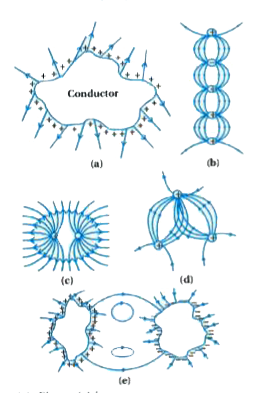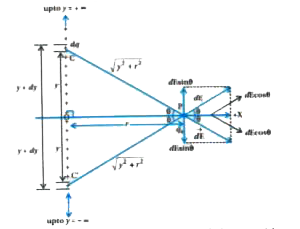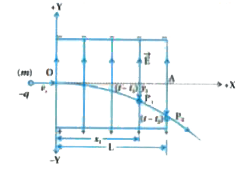Complete Solutions to SECTION B NUMERICALS (ADDITONAL EXERCISE) of chapter ELECTRIC CHARGES AND FIELDS of Class 12 book with complete answers and questions
| Class 12 | PHYSICS |
| Chapter | ELECTRIC CHARGES AND FIELDS |
| KUMAR PRAKASHAN | SECTION B NUMERICALS (ADDITONAL EXERCISE) |
| Number Of Questions | 10 |
| Academic Year | 2023-24 |
An oil drop of 12 excess electrons is held stationary under a constant electric field of `2.55 xx 10^4 NC^(-1)`. (Millikan's oil drop experiment). The density of the oil is `1.26 g cm^(-3)`. Estimate the radius of the drop, `(g = 9.81 ms^(-2), e = 1.60 xx 10^(-19 C))`.
View SolutionWhich among the curves shown in figure cannot possibly represent electrostatic field lines ?

View SolutionIn a certain region of space, electric field is along the z-direction throughout. The magnitude of electric field is, however, not constant but increases uniformly along the positive z-direction, at the rate of `10^5 NC^(-1)` per meter. What are the force and torque experienced by a system having a total dipole moment equal to `10^(-7)` cm in the negative z-direction ?
View Solution(a) A conductor A with a cavity as shown in figure (a) is given a charge Q. Show that the entire charge must appear on the outer surface of the conductor.
(b) Another conductor B with charge q is inserted into the cavity keeping B insulated from A. Show that the total charge on the outside surface of A is `Q + q` figure (b)
( C) A sensitive instruments is to be shielded from the strong electrostatic fields in its environment. Suggest a possible way.

View SolutionA hollow charged conductor has a tiny hole cut into its surface. Show that the electric field in the hold is `(sigma)/(2pi epsilon_(0))hatn` where `hatn` is the unit vector in the outward normal direction, and a is the surface charge density near the hole.

View SolutionObtain the formula for the electric field due to a long thin wire of uniform linear charge density E without using Gauss's law. (Hint: Use Coulomb's law directly and evaluate the necessary integral.)

View SolutionIt is now believed that protons and neutrons (which constitute nuclei of ordinary matter) are themselves built out of more elementary units called quarks. A proton and a neutron consist of three quarks each. Two types of quarks, the so called 'up' quark (denoted by u)
of charge `+2/3`e and the down quark denoted by d) of charge `(-1/3e)`, together with electrons build up ordinary matter. (Quarks of other types have also been found which give rise to different unusual varieties of matter.) Suggest a possible quark composition of a proton and neutron.
View Solution(a) Consider an arbitrary electrostatic field configuration. A small test charge is placed at a null point (i.e., where E = 0) of the configuration. Show that the equilibrium of the test charge is necessarily unstable.
(b) Verify this result for the simple configuration of two charges of the same magnitude and sign placed a certain distance apart.
View SolutionA particle of mass m and charge (-q) enters the region between the two charged plates initially moving along x-axis with speed `v_x` (like particle 1 in figure. The length of plate is L and an uniform electric field E is maintained between the plates. Show that the vertical deflection of the particle at the far edge of the plate is `qEL^(2)//(2m v_(x)^(2))`.
Compare this motion with motion of a projectile in gravitational field discussed in Section 4.10 of Class XI Textbook of Physics.

View SolutionSuppose that the particle in Exercise in 1.33 is an electron projected with velocity `v_x = 2.0 xx 10^6 ms^(-1)` . If E between the plates separated by 0.5 cm is `9.1 xx 10^2` N/C, where will the electron strike the upper plate ?
`(|e| = 1.6 xx 10^(-19) C, m_(e) = 9.1 xx 10^(-31) kg)`
View Solution
SECTION B NUMERICALS (ADDITONAL EXERCISE) questions and complete solutions for chapter ELECTRIC CHARGES AND FIELDS of KUMAR PRAKASHAN KENDRA PHYSICS (GUJRATI ENGLISH) of Class 12
All Exercises from KUMAR PRAKASHAN Class 12 PHYSICS ELECTRIC CHARGES AND FIELDS
- SECTION A QUESTIONS- ANSWERS
- SECTION A QUESTIONS- ANSWERS ( Higher Order Thinking Skills (HOTS) Unification Of Electricity And Magnetism)
- SECTION A QUESTIONS- ANSWERS (ADDITIVITY OF CHARGES)
- SECTION A QUESTIONS- ANSWERS (APPLICATION OF GAUSS.S LAW)
- SECTION A QUESTIONS- ANSWERS (BASIC PROPERTIES OF ELECTRIC CHARGE)
- SECTION A QUESTIONS- ANSWERS (CHARGE IS CONSERVED)
- SECTION A QUESTIONS- ANSWERS (CHARGING BY INDUCTION)
- SECTION A QUESTIONS- ANSWERS (CONDUCTORS AND INSULATORS)
- SECTION A QUESTIONS- ANSWERS (CONTINOUS CHARGE DISTRIBUTION)
- SECTION A QUESTIONS- ANSWERS (COULOMB.S LAW)
- SECTION A QUESTIONS- ANSWERS (DIPOLE IN UNIFORM EXTERNAL FIELD)
- SECTION A QUESTIONS- ANSWERS (ELECTRIC DIPOLE)
- SECTION A QUESTIONS- ANSWERS (ELECTRIC FIELD LINES)
- SECTION A QUESTIONS- ANSWERS (ELECTRIC FLUX)
- SECTION A QUESTIONS- ANSWERS (FIELD DUE TO A UNIFORMLY CHARGED THIN SPHERICAL SHELL)
- SECTION A QUESTIONS- ANSWERS (FIELD DUE TO AN INFINITELY LONG STRAIGHT UNIFORMLY CHARGED WIRE)
- SECTION A QUESTIONS- ANSWERS (FIELD DUE TO AN UNIFORMLY CHARGED INFINITE PLANE SHEET)
- SECTION A QUESTIONS- ANSWERS (FORCES BETWEEN MULTIPLE CHARGES)
- SECTION A QUESTIONS- ANSWERS (GAUSS.S LAW)
- SECTION A QUESTIONS- ANSWERS (PHYSICAL SIGNIFICANCE OF DIPOLES)
- SECTION A QUESTIONS- ANSWERS (THE FIELD OF AN ELECTRIC DIPOLE)
- SECTION A QUESTIONS- ANSWERS (TRY YOURSELF )
- SECTION B NUMERICALS (ADDITONAL EXERCISE)
- SECTION B NUMERICALS (NUMERICAL FOR .DARPAN. BASED ON TEXTBOOK)
- SECTION B NUMERICALS (NUMERICAL FROM TEXTUAL EXERCISES)
- SECTION B NUMERICALS (NUMERICAL FROM TEXTUAL ILLUSTRATIONS)
- SECTION C NCERT EXEMPLAR SOLUTION (LONG ANSWER TYPE QUESTIONS)
- SECTION C NCERT EXEMPLAR SOLUTION (MULTIPLE CHOICE QUESTIONS (MCQs))
- SECTION C NCERT EXEMPLAR SOLUTION (MULTIPLE CHOICE QUESTIONS (MORE THAN ONE OPTION))
- SECTION C NCERT EXEMPLAR SOLUTION (SHORT ANSWER TYPE QUESTIONS)
- SECTION C NCERT EXEMPLAR SOLUTION (VERY SHORT ANSWER TYPE QUESTIONS)
- SECTION D (MULTIPLE CHOICE QUESTIONS (MCQS)) (MCQS FROM .DARPAN. BASED ON TEXTBOOK) (ASSERTION AND REASON TYPE MCQs)
- SECTION D (MULTIPLE CHOICE QUESTIONS (MCQS)) (MCQS FROM .DARPAN. BASED ON TEXTBOOK) (CONTINUOUS DISTRIBUTION OF CHARGE AND ELECTRIC FLUX)
- SECTION D (MULTIPLE CHOICE QUESTIONS (MCQS)) (MCQS FROM .DARPAN. BASED ON TEXTBOOK) (ELECTROSTATIC ELECTRIC CHARGE AND FRICTIONAL ELECTRICAL CHARGE)
- SECTION D (MULTIPLE CHOICE QUESTIONS (MCQS)) (MCQS FROM .DARPAN. BASED ON TEXTBOOK) (LECTRIC FIELD AND ELECTRIC DIPOLE)
- SECTION D (MULTIPLE CHOICE QUESTIONS (MCQS)) (MCQS FROM .DARPAN. BASED ON TEXTBOOK) (MISCELLANEOUS MCQs)
- SECTION D MCQS ASKED IN COMPETITIVE EXAMES (MCQS AKSED IN BOARD EXAM AND GUJCET)
- SECTION D MCQS ASKED IN COMPETITIVE EXAMES (MCQS ASKED IN AIEEE AND JEE MAINS)
- SECTION D MCQS ASKED IN COMPETITIVE EXAMES (MCQS ASKED IN CBSE-PMT AIPMT NEET)